Influence of Uneven Subgrade Frost Heave on Deformation and Damage of CRTSIII Slab Track
Abstract
:1. Introduction
2. Concrete Plastic Damage Model Based on Damage Mechanics
2.1. Theory of Concrete Plastic Damage
2.2. Concrete Damaged Plasticity Parameters
3. Computational Model
3.1. CRTSIII Slab Track Numerical Model
3.2. Description of Subgrade Frost Heave
3.3. Model Verification
4. Results and Discussion
4.1. Superiority of the Damage Plasticity Model Compared with a Linear Elastic Model
4.2. Influence of Frost Heaving Positions on Subgrade
4.3. Influence of the Subgrade Frost Heaving Geometric Parameters
4.3.1. Influence on Track Structure Deformation and Interlayer Seam
4.3.2. Influence on the Track Structure Stress and Damage
5. Conclusions
- (1)
- Based on the concrete damage plasticity theory, the damage plasticity parameters of concrete in a track structure are deduced and the correctness of the parameters is verified. The damage plastic model can reflect the softening behavior and stress attenuation phenomenon of the concrete in the track structure after reaching tensile strength. The analytical results are consistent with the on-site condition, which fully demonstrates the necessity and superiority of considering plastic damage on concrete materials.
- (2)
- The peak value of the seam between the self-compacting concrete and the base normally occurs at the self-compacting concrete edge. When the frost heaving wave peak appears at the position that is one-sixth of the base length from the edge of the concrete base (e), due to the lack of longitudinal constraints at the base edge and the formation of a lever system in the middle of the self-compacting concrete, the seam between layers reaches its maximum value at 7.94 mm. The maximum and minimum interlayer seams between the base and the subgrade surface occur when the frost heaving positions are at one-sixth of the base length from the edge of the concrete base (e) and the expansion joint of base (g), respectively.
- (3)
- When the frost heaving wave peak is on grooves in the middle of the base (b), initially, damage and macroscopic cracks of concrete base appear. When the frost heaving wavelength is 10 m, the frost heaving values corresponding to initial damage and macroscopic cracks are 2.43 and 3.83 mm, respectively. When the frost heaving position is near the slab center, the damage to the slab is significant. It occurs near the center of the slab.
- (4)
- The deformation of the track structure increases with an increase in frost heaving wavelength and frost heaving wave amplitude. It is mainly dominated by the frost heaving wave amplitude. The seam between layers decreases with an increase in frost heaving wavelength and increases with an increase in frost heaving wave amplitude. The frost heaving wavelength has a greater influence on the interlayer seam, and the interlayer seam is more sensitive to the frost heaving in the 10 m range wavelength.
- (5)
- When the frost heaving wave amplitude is 15 mm or less, the normal relationship between the maximum tensile stress of the base and the frost heaving amplitude is linear. At this moment, the base has not been damaged or the damage is limited. When the frost heaving wave amplitude reaches 15 mm, 25 mm, and 30 mm, the peak tensile stress of the base reaches the maximum tensile strength, and the stress attenuation phenomenon occurs. The corresponding minimum allowable frost heaving wavelengths are 10 m, 20 m, and 30 m, respectively.
- (6)
- The average damage factor for the base decreases with an increase in frost heaving wavelength and increases with an increase in frost heaving wave amplitude. With a decrease in the wave/amplitude ratio of frost heaving, an increase in damage to the base is observed. Here, it undergoes changes in three stages, namely: (i) no damage, (ii) bending damage on the upper surface, and (iii) reverse bending damage.
Author Contributions
Funding
Institutional Review Board Statement
Informed Consent Statement
Data Availability Statement
Conflicts of Interest
References
- Wang, J.J.; Wang, M.; Liu, W.B.; Zhao, Y. Technology of CRTSIII Ballastless Track System. Chin. Railw. 2017, 58, 11–15. [Google Scholar]
- Zhao, G. Study on Management Standard of Frost Heaving of Ballastless Track Subgrade on High-speed Railway in Severe Cold Regions. J. China Railw. 2016, 38, 1–8. [Google Scholar]
- Sheng, D.; Zhao, G.; Zhang, S.; Niu, F. Possible frost heave mechanisms in an unsaturated high-speed railway formation. In Proceedings of the 6th International Conference on Unsaturated Soils, UNSAT 2014, Sydney, Australia, 2–5 July 2014. [Google Scholar]
- Yang, G.T.; Yan, H.Y.; Cai, D.G.; Zhao, G.T.; Yao, J.P.; Chen, F. Experimental study on frost heave of high-speed railway subgrade in the seasonally frozen region. Jpn. Geotech. Soc. Spec. Publ. 2016, 2, 1699–1702. [Google Scholar] [CrossRef]
- Zhang, S.; Sheng, D.; Zhao, G.; Niu, F.; He, Z. Analysis of frost heave mechanisms in a high-speed railway embankment. Can. Geotech. J. 2016, 53, 520–529. [Google Scholar] [CrossRef]
- Xiaopei, C.; Bicheng, L.; Wenhao, C.; Yanke, L. Research on Deformation and Damage of CRTSⅢ Slab Track in Severe Cold Regions; Huazhong University of Science and Technology: Wuhan, China, 2019; Volume 47. [Google Scholar]
- Wang, C.; Zhang, R.; Zhao, X.; Zhou, Y. Frost heaving monitoring system and frost heaving rules for the high-speed railway embankment in the seasonally frozen soil regions. J. Glaciol. Geocryol. 2014, 36, 962–968. [Google Scholar]
- Yu, L. Observation and Analysis on Frost Heaving Deformation at Subgrade of Haerbin-Dalian PDL. Subgrade Eng. 2013, 3, 54 58+63. [Google Scholar]
- Zhao, G.T.; Liu, X.B.; Gao, L.; Cai, X. Characteristic Analysis of Track Irregularity in Subgrade Frost Heave Area of Harbin-Dalian High-speed Railway. J. China Railw. Soc. 2016, 38, 105–109. [Google Scholar]
- Cheng, R.; Yan, B.; Xie, H. Track Irregularity and Mechanical Characteristics Analysis of CRTS I Ballastless Track Under Subgrade Frost Heaving. In Proceedings of the IABSE Conference: Risk Intelligence of Infrastructures, Seoul, Republic of Korea, 9–10 November 2020. [Google Scholar]
- Zhao, G.; Zhao, L.; Zhang, L. Mechanical Characteristics of Ballastless Track under Subgrade Frost Heaving in High-speed Railway. J. Railw. Eng. Soc. 2017, 34, 53–61. [Google Scholar]
- Hao, X.; Wenfeng, C.; Ping, W. Research on the Influence of Subgrade Frost Heave on CRTS III Slab Ballastless Track. J. Railw. Eng. Soc. 2019, 36, 27 32+40. [Google Scholar]
- Zhang, Y.Z.; Du, Y.L.; Sun, B.C.; Zhang, S.P.; Han, J. Roadbed deformation of high-speed railway due to freezing-thawing process in seasonally frozen regions. Chin. J. Rock Mech. Eng. 2014, 33, 2546–2553. [Google Scholar]
- Guanghua, S. Sunny-shady Slope Effect on Stress and Deformation of Ballastless Track in Transition Section. Chin. Railw. 2022, 3, 109–117. [Google Scholar]
- Jianmin, G.; Yi, G.; Yu, G. Dynamic Influence of Uneven Frost Heaving Deformation of High-speed Railway Subgrade on Wheel-rail System. J. China Railw. Soc. 2019, 41, 94–102. [Google Scholar]
- Cai, X.; Liang, Y.; Xin, T.; Ma, C.; Wang, H. Assessing the effects of subgrade frost heave on vehicle dynamic behaviors on high-speed railway. Cold Reg. Sci. Technol. 2018, 158, 95–105. [Google Scholar] [CrossRef]
- Gao, L.; Zhao, W.; Hou, B.; Zhong, Y. Analysis of Influencing Mechanism of Subgrade Frost Heave on Vehicle-Track Dynamic System. Appl. Sci. 2020, 10, 8097. [Google Scholar] [CrossRef]
- Pu, J.; Jieling, X.; Liyuan, Z.; Sixin, Y.; Hao, L. Study on nonlinear damage mechanism of CRTS III slab track in seasonal frozen region. J. Railw. Sci. Eng. 2021, 18, 1686–1695. [Google Scholar]
- Cai, X.; Zhang, Q.; Wang, Q.; Cui, X.; Dong, B. Effects of the subgrade differential arch on damage characteristics of CRTS III slab track and vehicle dynamic response. Constr. Build. Mater. 2022, 327, 126982. [Google Scholar] [CrossRef]
- Cai, X.; Zhang, Q.; Zhang, Y.; Wang, Q.; Luo, B.; Yang, G.; Lau, A. Deformation Law and Control Limit of CRTSIII Slab Track under Subgrade Frost Heave. Appl. Sci. 2021, 11, 3520. [Google Scholar] [CrossRef]
- Dongbin, Y.; Haibao, H.; Zhenyong, L. Solutions to Frost Heave of Railway Subgrade in Seasonal Frozen Soil Region. J. Technol. 2021, 21, 239–242. [Google Scholar]
- Weiping, L. Treatment Technology of Subgrade Frost Heaving for High Speed Railway in Severe Cold Area. Railw. Eng. 2016, 4, 92–97. [Google Scholar]
- Guotao, Y. Study on Subgrade Frost Heave Mechanism and Line Regularity Control Technology of High-Speed Railway in High-Cold Regions; Beijing Jiaotong University: Beijing, China, 2020. [Google Scholar]
- Lubliner, J.; Oliver, J.; Oller, S.; Oñate, E. A plastic-damage model for concrete. Int. J. Solids Struct. 1989, 25, 299–326. [Google Scholar] [CrossRef]
- Lee, J.; Fenves, G.L. Plastic-damage model for cyclic loading of concrete structures. J. Eng. Mech. 1998, 124, 892–900. [Google Scholar] [CrossRef]
- Ren, J.; Wang, J.; Li, X.; Wei, K.; Li, H.; Deng, S. Influence of cement asphalt mortar debonding on the damage distribution and mechanical responses of CRTS I prefabricated slab. Constr. Build. Mater. 2020, 230, 116995.1–116995.12. [Google Scholar] [CrossRef]
- Hl, A.; Sk, B.; Mawc, D.; Cuong-Le, T. A concrete damaged plasticity model for predicting the effects of compressive high-strength concrete under static and dynamic loading. J. Build. Eng. 2021, 44, 103239. [Google Scholar]
- GB 50010—2010; Housing and Urban-Rural Development of the People’s Republic of China. Code for Design of Concrete Structures. China Architecture & Building Press: Beijing, China, 2015.
- Guo, Y. Effects of Differential Subgrade Settlement and Its Evolution in High-Speed Railways on Mechanical Performance of Vehicle-Track Coupled System; Southwest Jiaotong University: Chengdu, China, 2018. [Google Scholar]
- Gao, L.; Zhao, L.; Qu, C.; Cai, X. Analysis on design scheme of CRTSIII slab track structure on roadbed. J. Tongji Univ. Nat. Sci. 2013, 41, 848–855. [Google Scholar]
- Hunt, H. Modelling of Rail Roughness for the Evaluation of Vibration-Isolation Measures. In Proceedings of the Twelfth International Congress on Sound and Vibration, Lisbon, Portugal, 11–14 July 2005. [Google Scholar]
- Hunt, H. Types of Rail Roughness and the Selection of Vibration Isolation Measures. In Proceedings of the 9th International Workshop on Railway Noise and Vibration, Munich, Germany, 4–8 September 2007; pp. 341–347. [Google Scholar]
- Auersch, L. Excitation of ground vibration due to the passage of trains over a track with trackbed irregularities and a varying support stiffness. Veh. Syst. Dyn. 2015, 53, 1–29. [Google Scholar] [CrossRef]
- Cui, X.; Ling, X. Effects of differential subgrade settlement on damage distribution and mechanical properties of CRTS II slab track. Constr. Build. Mater. 2021, 271, 121821. [Google Scholar] [CrossRef]
- Auersch, L.; Song, J. Dynamic damage quantification of slab tracks—Finite element models on Winkler soil and finite-element boundary-element models on continuous soil. CivilEng 2022, 3, 979–997. [Google Scholar] [CrossRef]
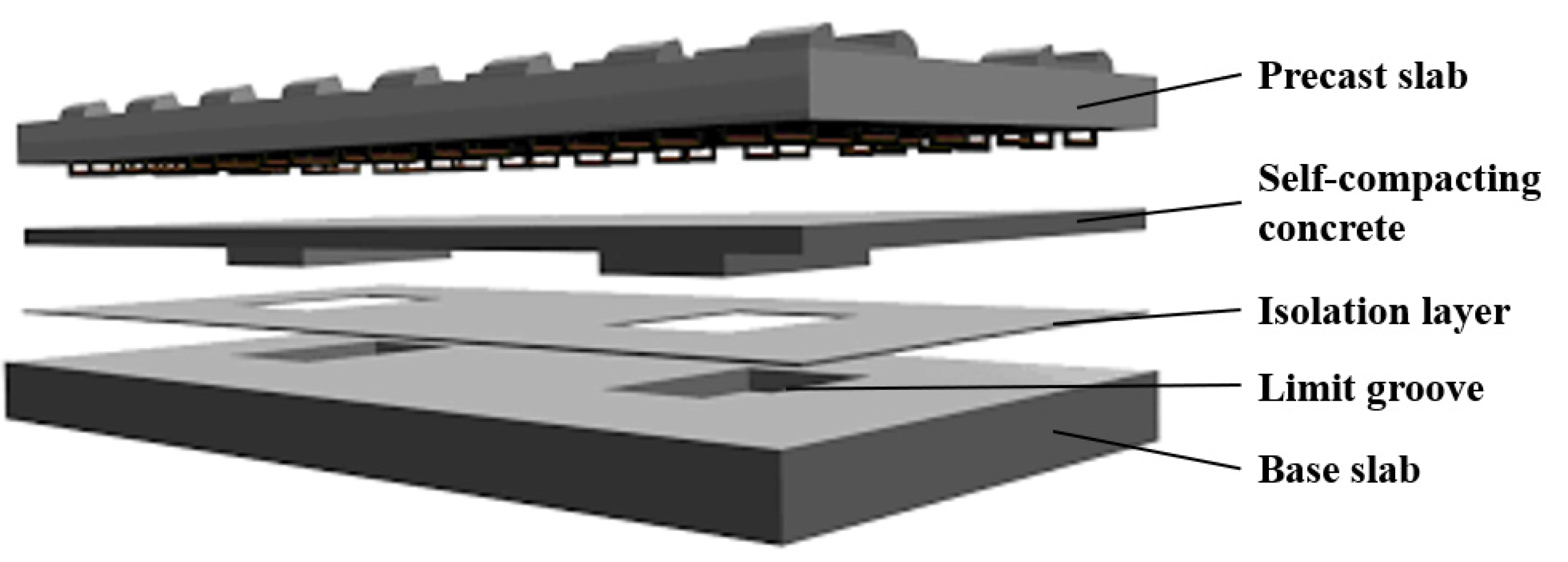
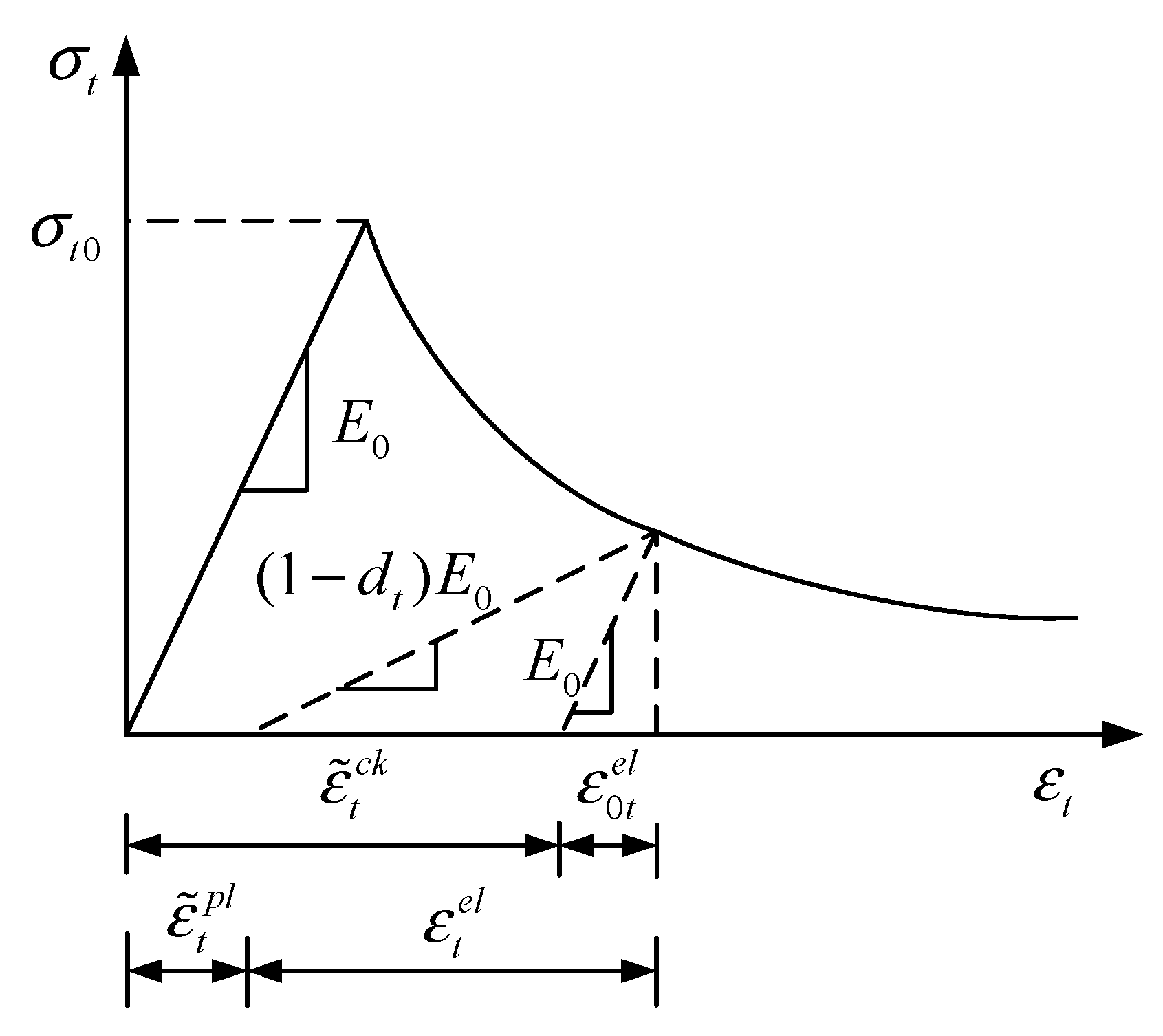


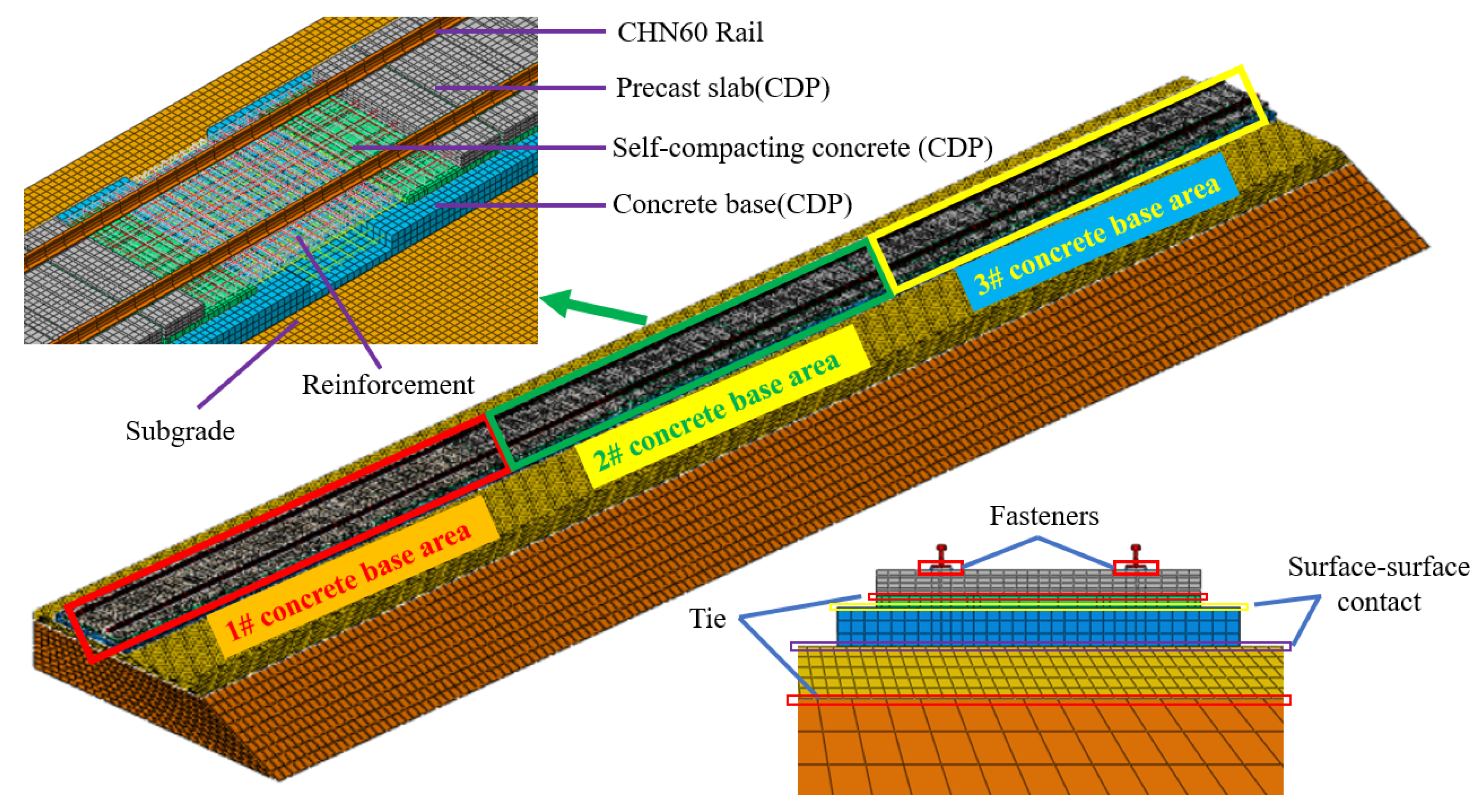

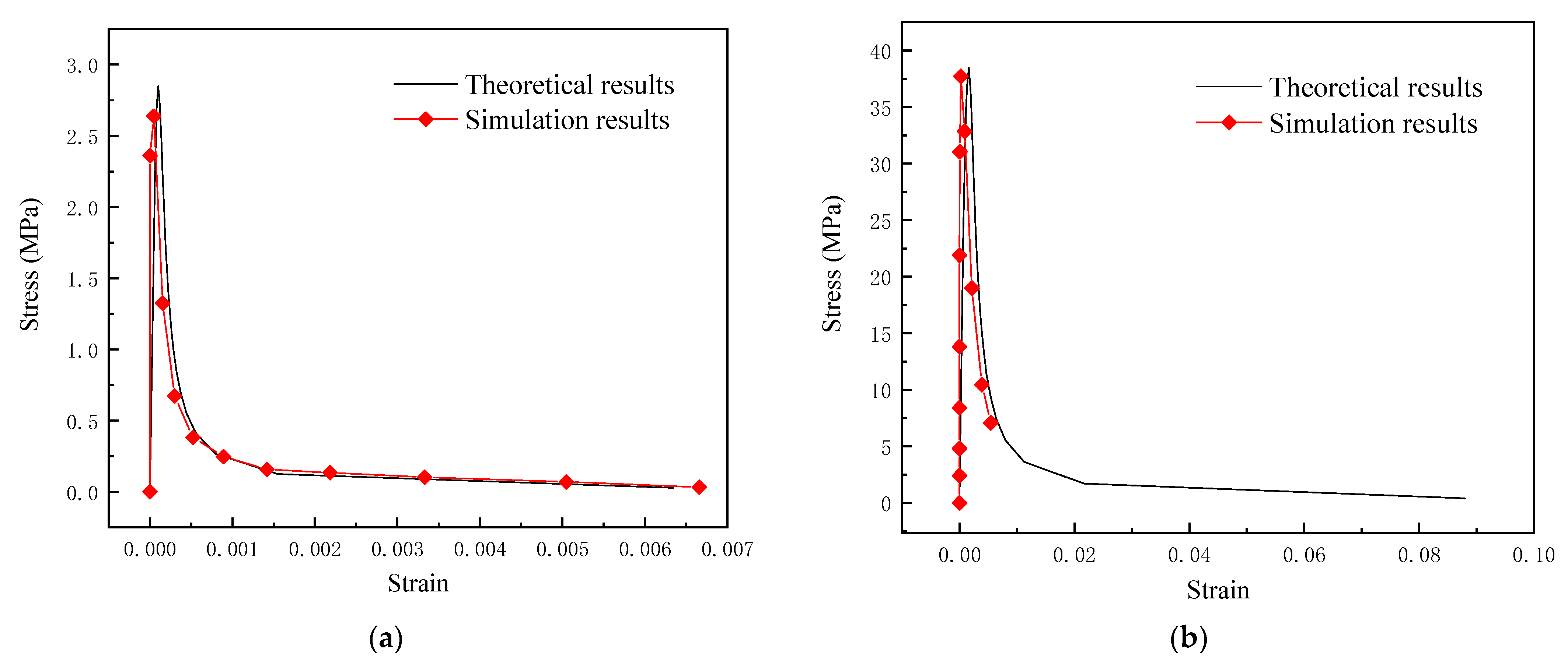



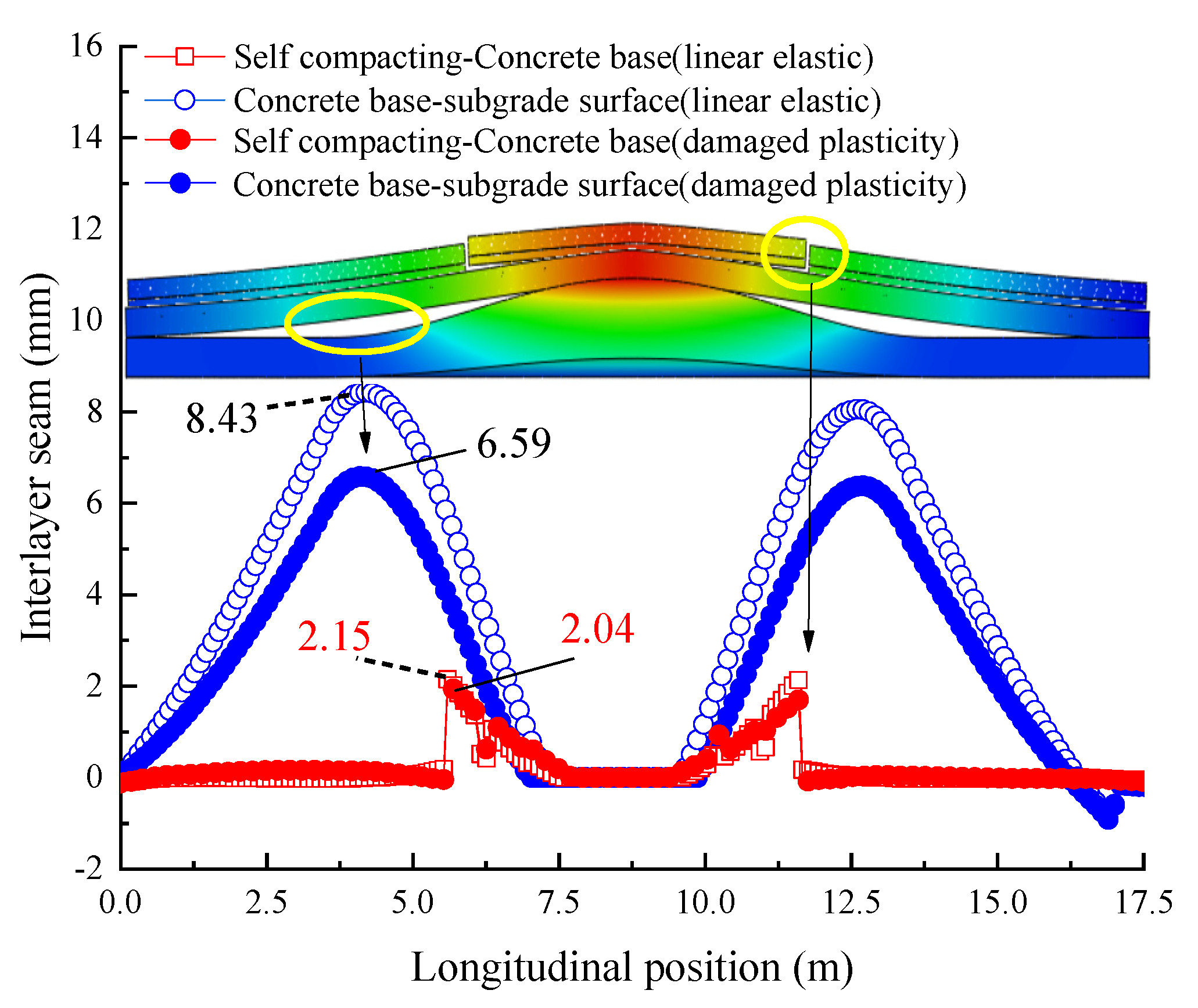


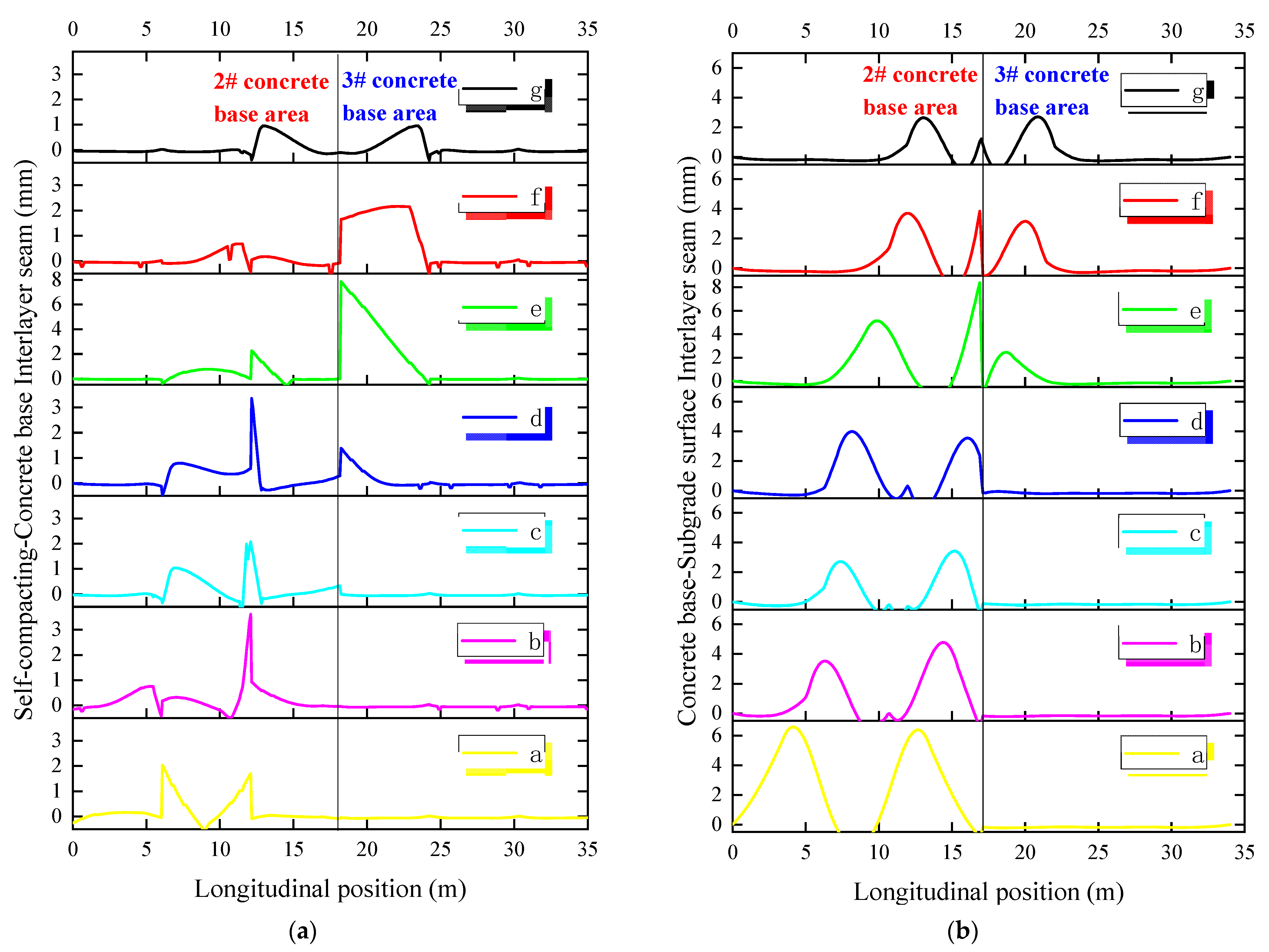
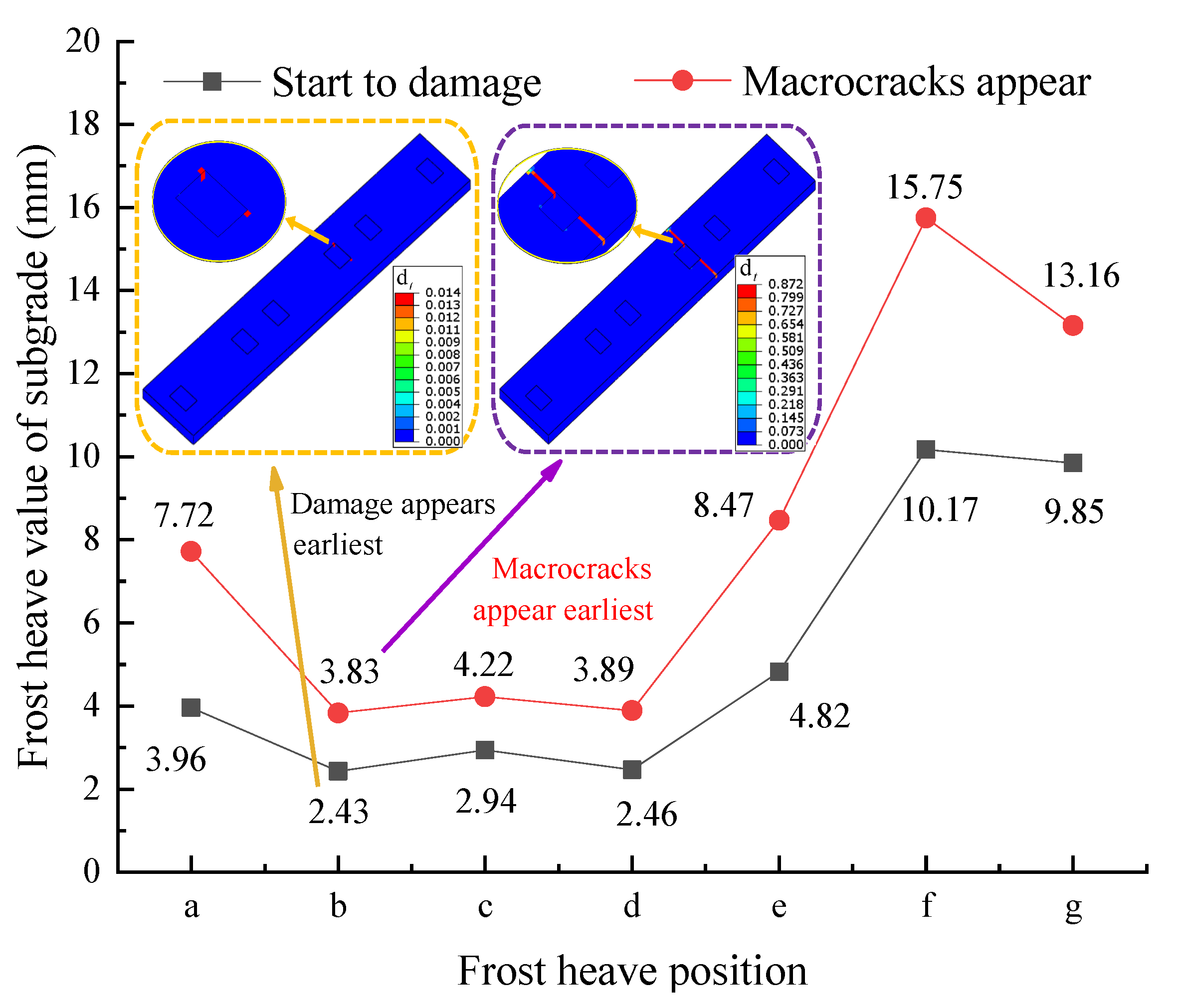

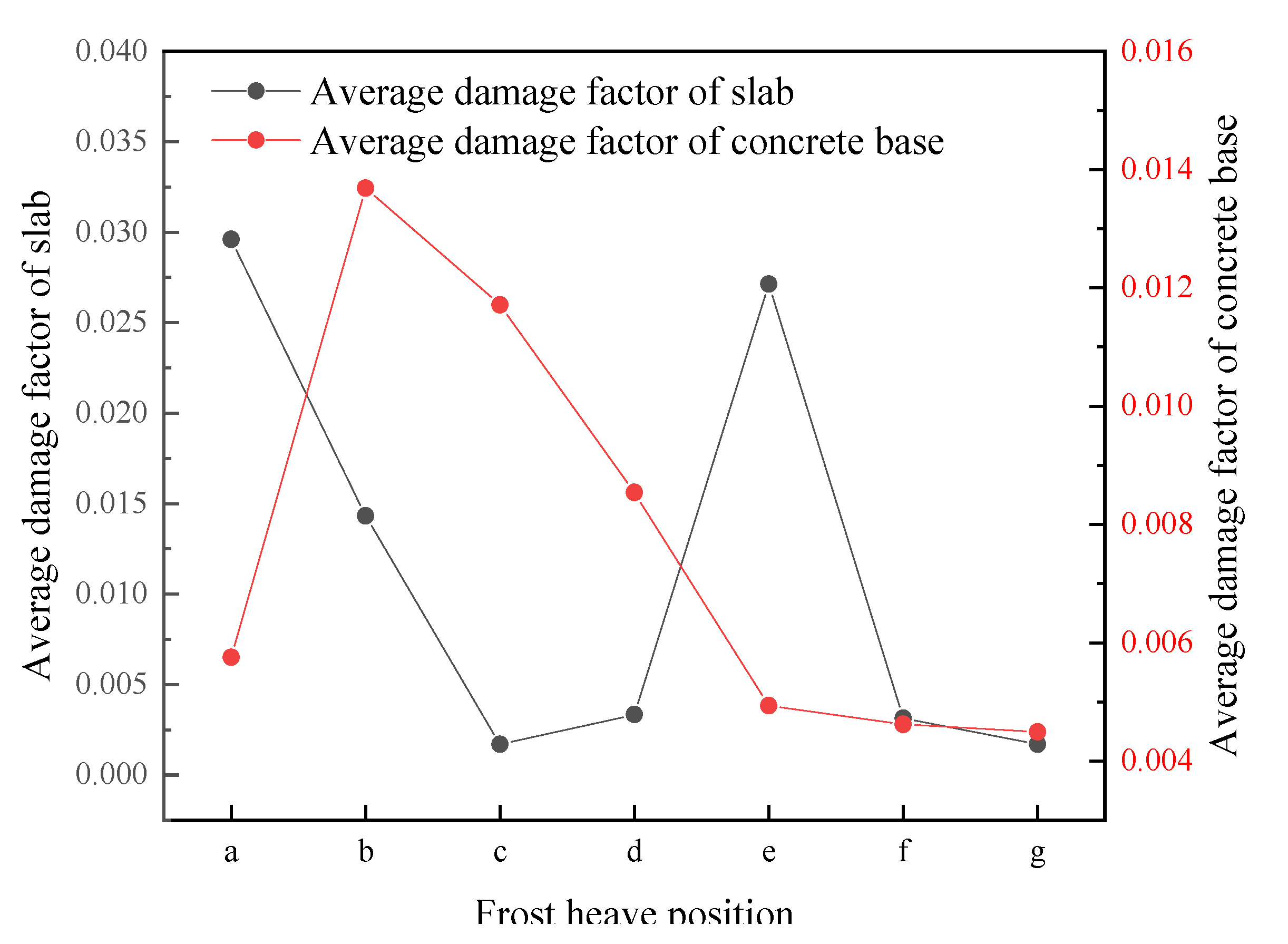

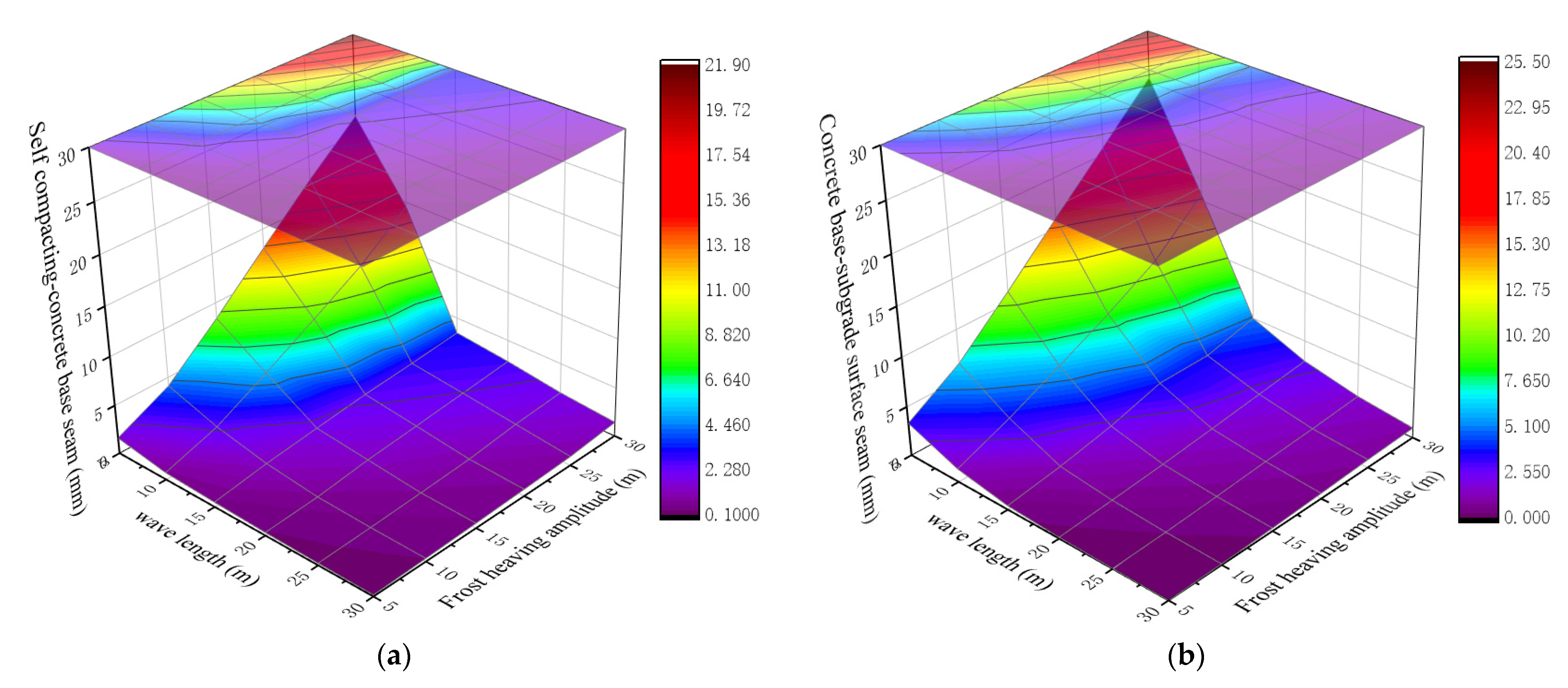
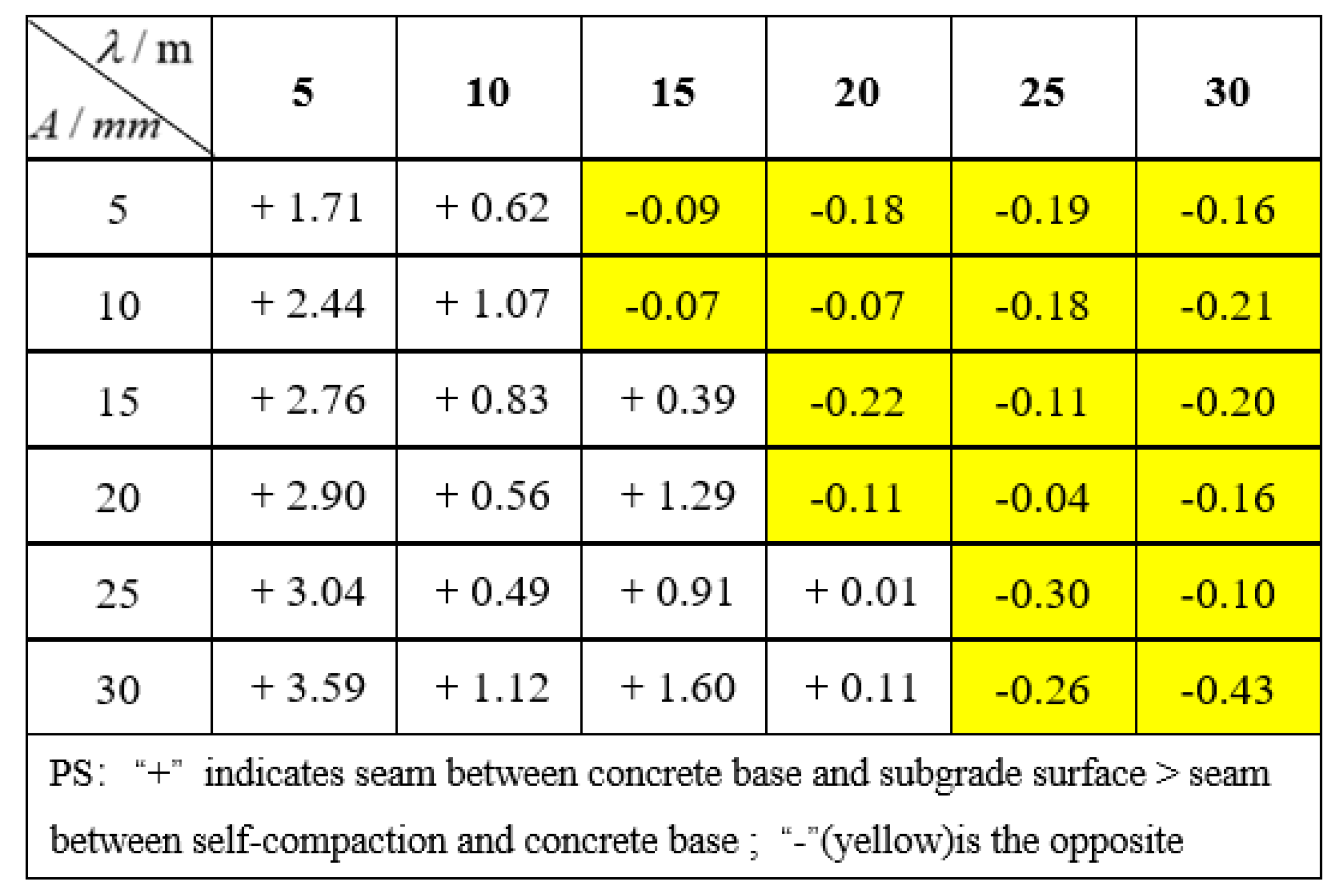
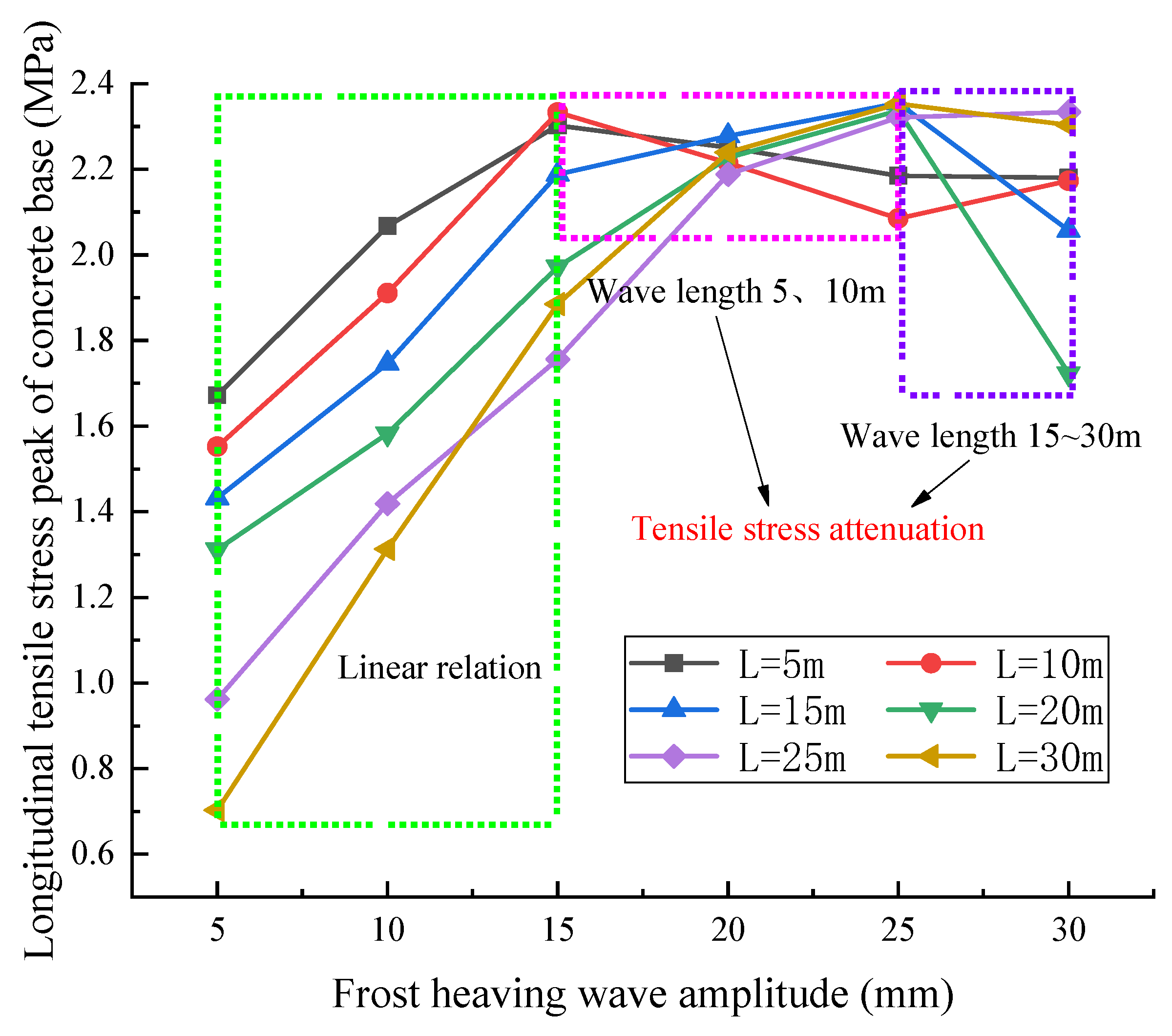
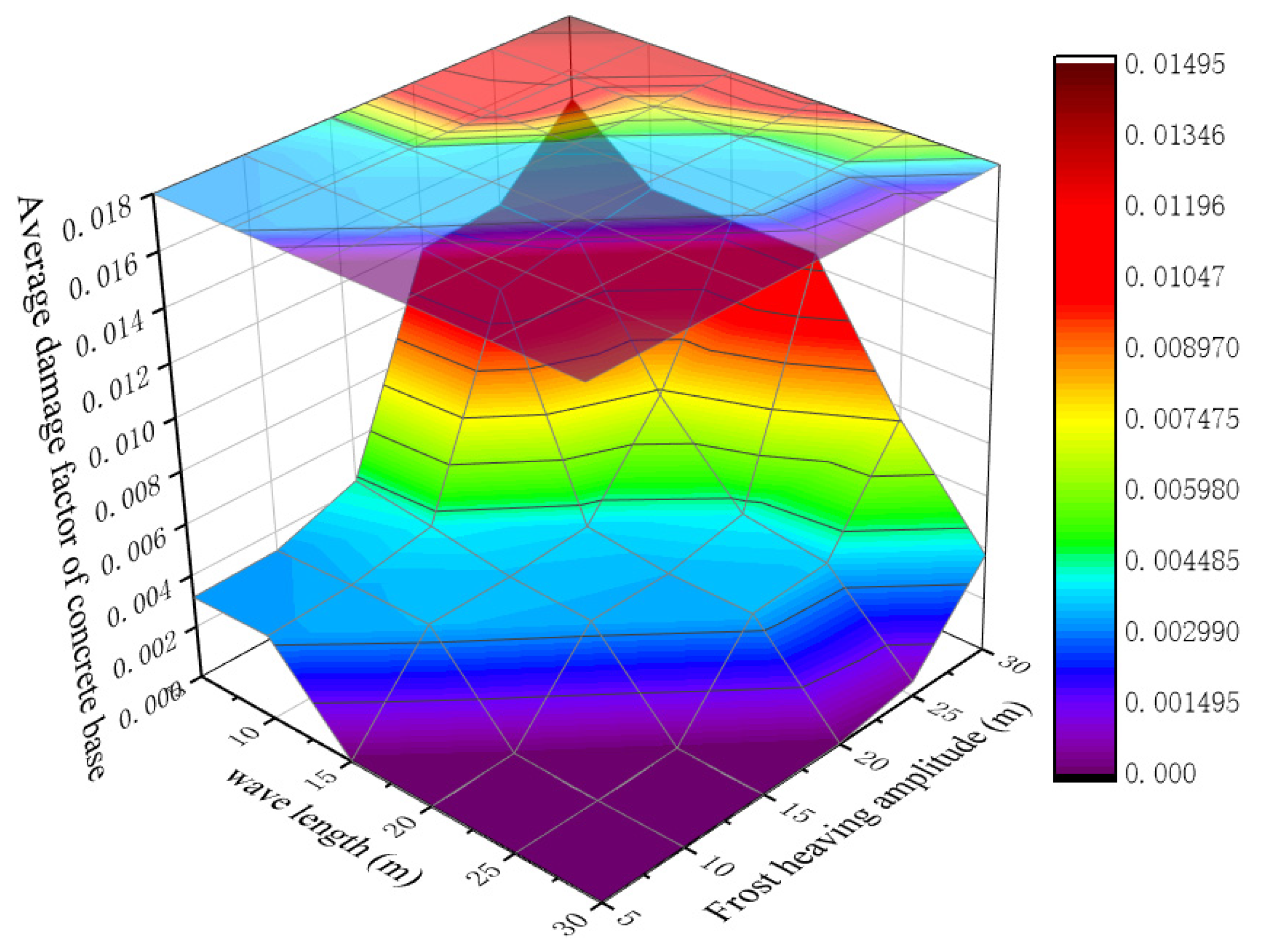

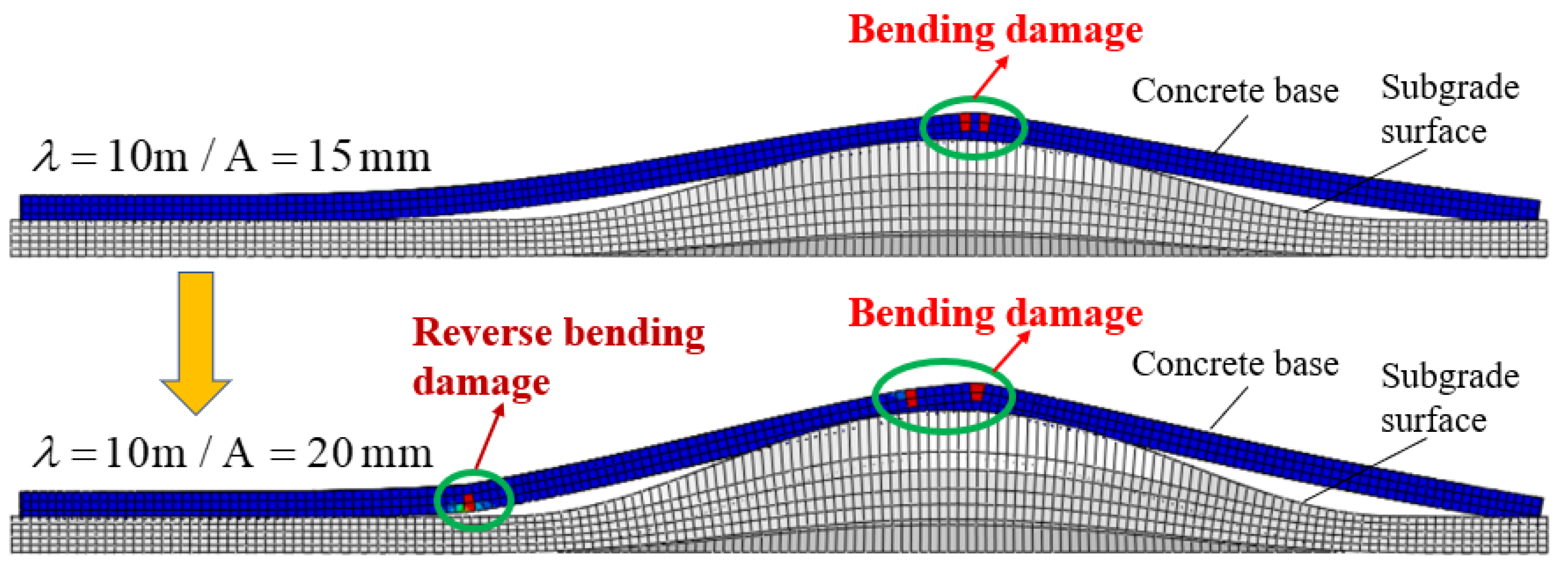
| Components | Size/m | Density (kg/m3) | Elastic Modulus (MPa) | Poisson’s Ratio | |
|---|---|---|---|---|---|
| CRTSIII slab track structure | Rail | —— | 7830 | 205,900 | 0.3 |
| Precast slab | 5.6 × 2.5 × 0.2 | 2440 | 36,000 | 0.2 | |
| Self-compacting concrete (lug boss limit) | 5.6 × 2.5 × 0.09 (0.7 × 1.0 × 0.1) | 2400 | 32,500 | 0.2 | |
| Concrete base (groove limit) | 16.99 × 3.1 × 0.3 (0.7 × 1.0 × 0.1) | 2400 | 32,500 | 0.2 | |
| Subgrade surface | 0.4 (thickness) | 2100 | 350 | 0.25 | |
| Subgrade underlying | 2.3 (thickness) | 2000 | 260 | 0.25 |
| Frost Heave Position | a | b | c | d | e | f | g |
|---|---|---|---|---|---|---|---|
| Peak position of interlayer seam | On the two edges of 2# slab | On the right edge of 2# slab | On the right edge of 2# slab and left edge of 3# slab | On the left edge of 3# slab | On the left edge of 4# slab | 2/3 length position of 4# slab | On the left edge of 3# slab; On the right edge of 4# slab |
| Peak value of interlayer seam (mm) | 2.08 | 3.67 | 2.08 | 3.36 | 7.94 | 2.26 | 1.01 |
| Vertical Displacement of Rail (mm) | |||||||
|---|---|---|---|---|---|---|---|
| λ/m | 5 | 10 | 15 | 20 | 25 | 30 | |
| A/mm | |||||||
| 5 | 3.72 | 4.22 | 4.51 | 4.62 | 4.67 | 4.70 | |
| 10 | 8.11 | 8.93 | 9.31 | 9.50 | 9.59 | 9.64 | |
| 15 | 12.77 | 13.76 | 14.12 | 14.40 | 14.52 | 14.59 | |
| 20 | 17.57 | 18.61 | 19.04 | 19.31 | 19.46 | 19.54 | |
| 25 | 22.36 | 23.48 | 24.04 | 24.22 | 24.41 | 24.50 | |
| 30 | 27.26 | 27.56 | 28.94 | 29.15 | 29.36 | 29.48 | |
| Vertical Displacement of Composite slab (mm) | |||||||
| λ/m | 5 | 10 | 15 | 20 | 25 | 30 | |
| A/mm | |||||||
| 5 | 3.77 | 4.29 | 4.57 | 4.68 | 4.72 | 4.75 | |
| 10 | 8.36 | 9.02 | 9.36 | 9.57 | 9.65 | 9.70 | |
| 15 | 13.03 | 13.95 | 14.19 | 14.46 | 14.59 | 14.65 | |
| 20 | 17.78 | 18.87 | 19.07 | 19.37 | 19.53 | 19.60 | |
| 25 | 22.55 | 23.72 | 24.28 | 24.29 | 24.46 | 24.56 | |
| 30 | 27.46 | 28.51 | 29.22 | 29.21 | 29.41 | 29.53 | |
| Vertical Displacement of Concrete Base (mm) | |||||||
| λ/m | 5 | 10 | 15 | 20 | 25 | 30 | |
| A/mm | |||||||
| 5 | 3.93 | 4.45 | 4.68 | 4.75 | 4.78 | 4.80 | |
| 10 | 8.67 | 9.26 | 9.49 | 9.69 | 9.74 | 9.77 | |
| 15 | 13.39 | 14.10 | 14.35 | 14.57 | 14.71 | 14.75 | |
| 20 | 18.17 | 18.98 | 19.24 | 19.49 | 19.66 | 19.72 | |
| 25 | 22.98 | 23.83 | 24.50 | 24.42 | 24.58 | 24.70 | |
| 30 | 27.87 | 28.67 | 29.48 | 29.35 | 29.53 | 29.63 | |
Disclaimer/Publisher’s Note: The statements, opinions and data contained in all publications are solely those of the individual author(s) and contributor(s) and not of MDPI and/or the editor(s). MDPI and/or the editor(s) disclaim responsibility for any injury to people or property resulting from any ideas, methods, instructions or products referred to in the content. |
© 2023 by the authors. Licensee MDPI, Basel, Switzerland. This article is an open access article distributed under the terms and conditions of the Creative Commons Attribution (CC BY) license (https://creativecommons.org/licenses/by/4.0/).
Share and Cite
Wang, H.; Xiao, H.; Cui, X.; Yang, S.; Nadakatti, M.M.; Guo, Q. Influence of Uneven Subgrade Frost Heave on Deformation and Damage of CRTSIII Slab Track. Appl. Sci. 2023, 13, 5345. https://doi.org/10.3390/app13095345
Wang H, Xiao H, Cui X, Yang S, Nadakatti MM, Guo Q. Influence of Uneven Subgrade Frost Heave on Deformation and Damage of CRTSIII Slab Track. Applied Sciences. 2023; 13(9):5345. https://doi.org/10.3390/app13095345
Chicago/Turabian StyleWang, Hongge, Hong Xiao, Xuhao Cui, Shusheng Yang, Mahantesh M. Nadakatti, and Qiang Guo. 2023. "Influence of Uneven Subgrade Frost Heave on Deformation and Damage of CRTSIII Slab Track" Applied Sciences 13, no. 9: 5345. https://doi.org/10.3390/app13095345





